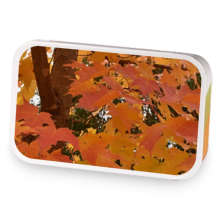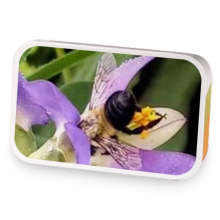
99
Monarch Cat on Milkweed
based on 1 review
sample tin
fall of 2025
3oz pouch
37¢ per cup
$14
5oz tin
38¢ per cup
$24



Hosting monarch caterpillars on my native milkweed (the orange-flowered Asclepias tuberosa species) was a special occurrence of 2021. My central Kentucky garden is only peripherally on the monarch's migration path-- I've had monarch "cats" 3 out of 8 years though the first "barely a garden" years really don't count. Nonetheless, fifty percent chance for me I'd say. Incidentally, the antennaed caterpillar end we're seeing in the photograph is actually the tail as the caterpillar crawls away. Both ends have antennae-- short on the head, long on the tail.
High caffeine | Steep at 195° for 3 mins
Signature blends are not eligible for returns.
Customer Reviews (1)
ingredients & lore
blended with green tea, pu-erh tea, apple pieces, rose hips, mango pieces, coconut, natural apricot flavor, papaya flavor, natural mango flavor, raspberries, rose petals, marigold flowers, natural coconut flavor & apricots



teas: pu-erh tahiti, apricot green & mango green
accented with apricots, mango & orange peel
***THE REST OF THE STORY*** Shortly after this picture was taken, the caterpillars crawled off to pupate. I didn't see even one chrysalis so I'm not sure specifically where the transformations occurred. However, there were two monarch butterflies fluttering around the garden and sipping nectar until the third week of October-- just before our first hard frost. I expect they began migrating but I didn't spot them thereafter. ***TEA BLEND CREATION*** As for the tea, yellow-orange fruity flavors were chosen to represent the milkweed flower color, the caterpillars' yellow stripes, and the orange of the monarch butterflies' wings. I had initially selected Papaya Pouchong as part of a moderate caffeine blend. Being a chopping block tea, that's out! Enter Pu-Erh Tahiti with its papaya flavoring and a high caffeine level instead. Papaya, mango, and coconut tastes point to the portion of monarchs' lives spent in tropical areas. Green tea was chosen for the green milkweed leaves which support the caterpillars' growth-- their ONLY food in fact, so if you want monarchs at your house, plant a milkweed species native to your area. ***MILKWEED AND GARDENING*** At least one study shows that monarch butterflies instinctively lay eggs on the youngest and healthiest milkweed plants available which will be species for your site's light and moisture levels plus native status, There are a slew of milkweed species so web search time. Hint: If you don't live in the tropics, don't plant tropical milkweed. After determining which milkweeds to grow, look for native plant sellers since ordinary nurseries seldom carry appropriate plants. You CAN of course grow your own plants, but milkweed seeds generally need 30-60 days of chilly outdoor weather to sprout (otherwise known as cold moist stratification) plus additional time to grow since caterpillars will be eating the leaves. Plant seeds in late fall or early to mid winter. Research winter sowing or simply wing it if you're the adventurous type. :)
this tea is part of the Kentucky Native Plant Garden fandom
Love Monarch Cat on Milkweed? This is just one of 6 teas in this fandom. Check out the whole series.
create the perfect fandom gift box
Now's your chance to create your very own custom fandom sampler set!
Select six samples of your favorite blends from any collection and we will create a box set unique to you.














